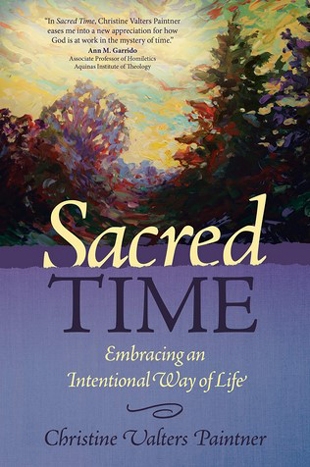Christine Valters Paintner, one of our profiled Living Spiritual Teachers, is the online abbess for Abbey of the Arts, a virtual monastery offering classes and resources on contemplative practice and creative expression. We’ve found great value in her work ever since her first book, Water, Wind, Earth, and Fire: The Christian Practice of Praying with the Elements, came out in 2010. She used the “Canticle of the Creatures” of Saint Francis of Assisi to reclaim the elements of nature as essential to expressing our spirituality.
Each of her books explores creativity and inspires awe in meaningful ways in our lives. This one is no different.
Most of us don’t need convincing that our time might be put to better and holier uses, and Paintner senses this. She doesn’t spend a lot of time convincing, but instead offers spiritual practice suggestions, movement explorations, prayers and blessings, scripture reflections (written by her husband, John), meditations on time-related themes, and original poems — which are favorites of many people who know her work.
Paintner often returns to themes from nature and the monastery. In the Introduction she writes about a retreat she took, where she discovered “my spirituality thrives when I can allow it to be organic — when I create enough space to respond to what the day offers. I am someone who loves to plan and make lists, and yet what is most life-giving for me in the overall arc of my life is to listen deeply to what my life is calling me toward and to shape my life in response.”
Throughout Sacred Time, she teaches us that it is not necessary to go anywhere to find or experience time’s holy potential. Instead, she shows us how to adjust our perspective and create new, more open paths to experiencing the flow of time as sacred.
Chapters are dedicated to presentations on breath, rhythms of the day, weekly rhythms, and Sabbath themes of rest, lunar cycles, seasons of the year, seasons of a lifetime, ancestral time (experiences we carry from our ancestors), and cosmic time (which reaches way beyond human experience both in the past and future). Examples are given from Christian tradition — most of all Celtic — but also from Islamic, Judaic, Jungian, Tibetan Buddhist, and Indigenous wisdom traditions.
In the “Seasons of a Lifetime” chapter, we appreciated this teaching, which represents many others like it in the book:
“After my mother died, I entered into a deep period of grief, and one of the things I found great comfort in was something a dear friend who was also a rabbi told me. She said that in Jewish tradition, in that first year after a significant loss, nothing extra is expected of the person. What a beautiful gift she offered to me by reminding me that this was a season of grief, and taking on new projects would not be honoring where I was. Similarly, in periods of my life when I have experienced a flare of my autoimmune illness, I have to ask whether the tasks I want to take on would be honoring my illness, in order to remind myself of a call to focus on healing.”
The excerpt that we selected to accompany this review offers the author’s interesting perspective on “Mythic Time” as something to discover, even as we worry about the possibility of a time-ending future for our planet.
